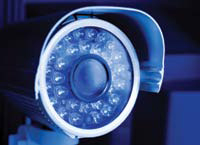Integrator's Guide To IP Video Cameras
By Business Solutions magazine.
 Most Significant Trends
Most Significant Trends
Edge Recording — "The decentralized surveillance system approach incorporates a high-speed computer and memory card into the camera. The PC and video control center serve for viewing and controlling video, rather than analyzing and recording. Therefore, it is no longer necessary to purchase separate video management software because the computer-intensive functions are integrated within the camera." Steve Gorski, general manager, Americas, MOBOTIX Corp.
Do More With Less — "Customers have always wanted better quality images, and until a few years ago the only way they could achieve that was with multiple cameras. Today, they can achieve better image quality and coverage by deploying relatively fewer megapixel cameras, which simplifies installation, reduces system complexity, and significantly cuts costs." Ed Suski, VP and CTO, IQinVision
Lower Prices — "The quality and output of the cameras continue to improve — sharper, better image quality — while, at the same time, the price point is going down. These factors provide great opportunity for dealers in the security market." Tony Sorrentino, president, ScanSource Security
Certification — "Vendors of IP-based surveillance cameras and video management systems are upping the ante on integration certification, providing integrators and users with documented validation of more comprehensive functional integrity between their respective platforms." Edward Wassall, director of IP product and business development, Samsung Techwin America
Options — "H.264 compression has virtually eliminated network bandwidth and storage capacity issues. The wide selection of megapixel cameras available allows system designers to specify the most efficient megapixel solution for each specific location. From an economic perspective, a one-megapixel camera can efficiently replace several conventional IP and/or analog cameras based upon their coverage assignments." Scott Schafer, executive VP, Arecont Vision
Advances In Night Recording — “Instead of a typical day/ night camera that switches to black and white to produce less noise and a usable image, “Lightfinder-enabled” cameras can deliver crisp, color surveillance video at night without the need for infrared illumination or artificial light. This is especially important for those surveillance installations that require such color detail for identification. For those end users who need only to detect at night, don’t forget that thermal network cameras are also available at a reasonable price point compared to their military-grade ancestors.” Steve Surfaro, security industry liaison, Axis Communications
Tips & Advice For Success
Leverage Choices — “Unlike CCTV or analog, the variety of IP cameras available today will aid you in solving your customers’ specific needs with an optimized solution. You now have many more options to effectively meet your customers’ needs in a way that works best for them.” Ed Suski, VP and CTO, IQinVision
Get Certified — “Integrators from the IT world already know how to install 90% of an IP video system. They’re likely already certified on the same router, switch, storage, and cabling technologies required. Take some courses, and get certified.” Steve Surfaro, security industry liaison, Axis Communications
Don’t Give Up Your High Ground — “IT integrators should promote their expertise with network-based technologies over that of traditional low-voltage security dealers who, many times, do not fully understand the complexities of networked integrated solutions. He who owns the network, in the mind of the customer, always has an inside track as to solutions that get placed on that network.” Jeff Brummett, VP of security solutions, BlueStar
Not All Cameras Are Created Equal — “Integrators should become familiar with the new class of wide dynamic range cameras, as these represent a significant new addition to their portfolio alongside color and day/night cameras and other cameras. Integrators should test these cameras and get very familiar with the types of scenes in which they excel — scenes with difficult light, low light, or bright shining lights.” Scott Paul, senior product marketing manager, Pelco by Schneider Electric
